The mysterious Monstera Borsigiana is one of the most widely debated Monstera plants around. Sources are at odds about whether this variety is a distinct breed in its own right or simply a subspecies of the popular and easy-to-obtain Deliciosa. Further complicating this conundrum are multiple questions around how to distinguish the two, with suggestions ranging from ruffled leaf joints to growth rate.
In short, the answer is quite simple. Borsigiana is a subspecies of Deliciosa. While generally accepted as a smaller, faster-growing version of its parent plant, the minor differences between them can be impossible to establish with any certainty, especially when they are young. Irrespective, Borsigiana remains a beautiful, thrilling plant for beginners and collectors alike and never disappoints in its ease of care.
In this post, we’ll look at how best to tell a Borsigiana from a Deliciosa, how to care for one and meet its needs, and how to help them climb. We’ll also unpack whether or not these beauties can be variegated, and importantly, exactly how to pronounce their name.
Ready? Let’s jump right in.
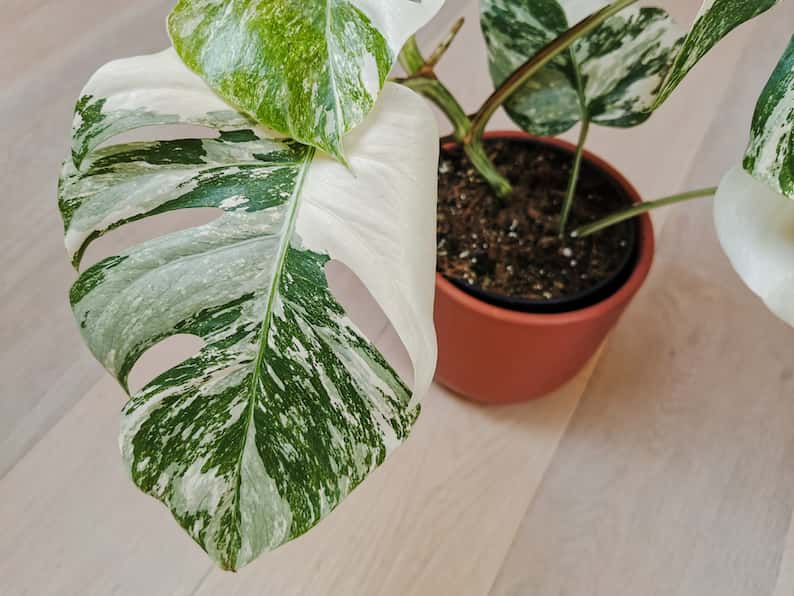
Table of Contents
What’s the difference between Monstera Borsigiana and Deliciosa?
The main difference between the Borsigiana and Deliciosa is in their leaf joint, also known as a geniculum. The Deliciosa’s is indented and ruffled while the Borsigiana’s geniculum is entirely smooth. Furthermore, the Deliciosa has bigger leaves than the Borsigiana, but this is difficult to establish as growing conditions significantly impact how large a plant will get.
Overall, Monstera Borsigiana is a subspecies of Deliciosa and thus there are only minor differences between them. In their juvenile phases, the Monstera Borsigiana and the Deliciosa are impossible to tell apart. For this reason, debates rage as to whether the Borsigiana need even be classified as a subspecies, and many do not recognize it as such.
However, for the purpose of this article, I’ll be taking you through all the known ways to identify a Borsigiana from its larger cousin, as I’m a firm believer this Monstera stands on her own two feet. Granted, differences between them can be hard to spot, but if you know what to look for, they become quite clear (once they reach maturity). The most obvious tell lies
While the point about the geniculum above is important to note, a better way to go about determining which species you have is to look at the manner in which they grow. The Deliciosa tends to grow horizontally and sprawl, whereas the Borsigiana tends to vine and grow upwards. The Deliciosa also has larger gaps between its nodes.
As a final step to solving this mystery, you can also look at your Borsigiana’s growth rate. These lovely Monstera grow much more rapidly indoors than Deliciosa, even though they remain smaller. Considering this, it often happens that Monstera Deliciosa are incorrectly marked when they are, in fact, Borsigiana instead.
Is Borsigiana and Deliciosa the same?
Contrary to what some plant enthusiasts believe, Borsigiana and Deliciosa are not the same, and there is a slight difference in their taxonomy. While they are both Monstera and both part of the Araceae family, the Borsigiana is classified as a subspecies of Monstera Deliciosa.
Their root taxon is the same, but they fall under different types due to their differences in leaf size, geniculum, stem structure, and growth rate.
How do you identify Monstera Borsigiana?
The easiest way to identify a Monstera Borsigiana is to look at its leaf joints, which are smooth and thus different in structure and texture compared to other plants. A second clear indicator is the way in which they vine, in that the Borsigiana grows upward in a vining pattern when allowed to climb.
As outlined above, the Borsigiana is slightly different in appearance to the Deliciosa, but you will need to inspect it closely. It is also much easier to spot their differences when they are mature. As juveniles, they look identical.
However, as mentioned, the Borsigiana vs Deliciosa difference is easier to work out as they mature, with the latter having a ruffled or wrinkled texture at the spot where a leaf joins the stem. Monstera Deliciosa are also larger, and their leaves tend to grow more horizontally and in a rather haphazard manner.

Monstera Borsigiana care
The Monstera Borsigiana is exceptionally easy to grow and care for, making it an excellent houseplant choice. They require a minimum of six hours of bright, indirect light per day, well-draining soil, regular watering, and high humidity. Occasional feeding is beneficial for promoting growth.
If you’re on the hunt for a low-maintenance showstopper, the Borsigiana is, without a doubt, the plant for you. These beautiful Monstera require minimal care but reward their owners greatly with excellent growth. And with their big, dark green leaves, they’re also just really good-looking.
To keep your Monster Borsigiana happy and healthy, there are a few key fundamentals to bear in mind. Where you position your plant in your home will determine how well it grows, as these jungle-dwellers love light and humidity (more on this in a bit!).
Furthermore, make sure your plant is set in good-quality soil. As avid growers, Borsigiana need lots of nutrients, so their ideal potting mix will contain mineral-rich substances like bark or moss, as well as moisture-retentive perlite. In the hot months of the year, a slow-release fertilizer can be used for a little extra boost. Most important is making sure your soil mix is airy rather than dense.
Water-wise, Monstera Borsigiana owners must exercise a bit of caution to avoid root rot. A regular schedule of weekly hydration can work, but it’s better to water them on a need-to-have basis by waiting for the top two inches of their soil to dry out. This way, you reduce the risk of your Monstera developing root rot from overwatering. If you’re unsure when your plant might need water, invest in a moisture meter and keep the level between 2 and 3.
On that note, consistently underwatering your plant can also harm it. While it’s okay to let it dry out from time to time, don’t make a habit of this as it can cause irreversible damage to your Borsigiana’s big green leaves.
Monstera Borsigiana light needs
Monstera Borsigiana prefers bright, indirect light and so it is recommended that you set your plant a few feet back from a North- or East-facing window that receives a minimum of six hours of light per day. The light needn’t be harsh, but just bright enough so that your Borsigiana can thrive in its energy.
As mentioned, positioning is everything when it comes to getting a Borsigiana to flourish. Monstera Borsigiana’s big green leaves need lots of energy from the sun to grow and fenestrate, but at the same time, they are also sensitive to direct light and tend to scorch with prolonged exposure.
If you’re not able to provide a Monstera with its light requirements by placing it in a location near one of the abovementioned windows, the good news is that they can also manage in lower light conditions, but they’re unlikely to grow as efficiently and may take on a leggy appearance. But never fear. If needed, this can be rectified to a degree by a low grow light.
Find out more about using a grow light for this plant, including our top pick for the best grow light for Monstera.
Monstera Borsigiana humidity needs
Monstera Borsigiana are tropical plants that originated in the jungles of Central and South America, so it follows that they like warmer climates and plenty of humidity. Indoors, they fare best in temperatures between 60F and 80F (15C and 27C) with humidity levels above 50%.
If your Monstera’s humidity levels aren’t quite up to scratch, you can supplement your plant with regular leaf misting, a humidifier, or a damp pebble tray (or a combination of these things). Clustering several houseplants together is also a mutually beneficial way to ramp up the humidity in a space. And if all else fails, keep your Borsigiana in a damper spot like a bright bathroom or kitchen.
Finally, try to avoid placing your Monstera in areas that are drafty or close to extreme hot and cold temperatures, like near heaters or air conditioners. They intensely dislike drastic fluctuations in temperature and may act out by wilting, drooping, or dropping their leaves.
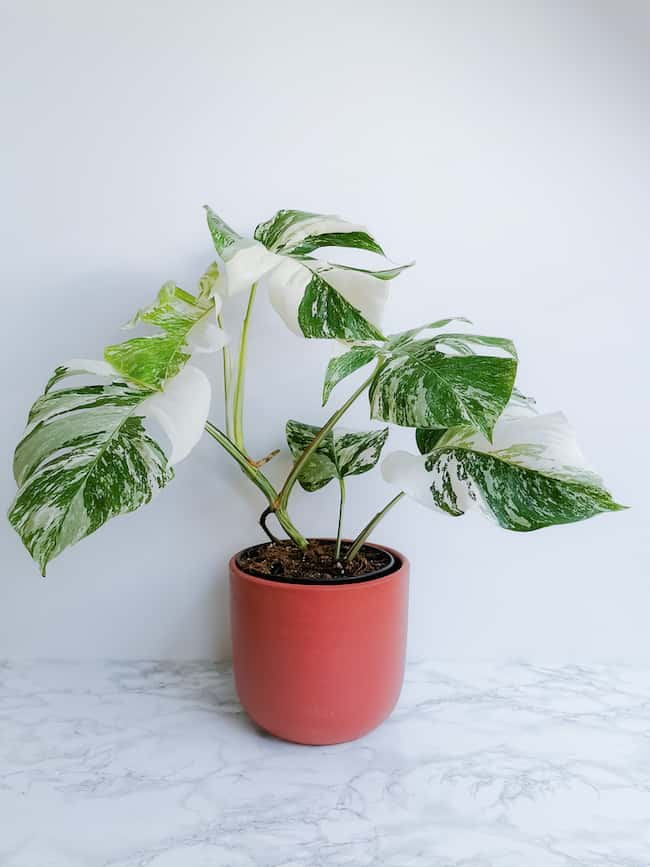
How often should I water Monstera Borsigiana?
You should water your Monstera Borsigiana whenever the top two inches of its soil are dry. The best way to test this is by sticking your finger into your plant’s potting mix. When the top few inches feel dry, water it slowly until water begins to come through the pot’s drainage holes.
You should also make sure your plant’s drip tray is emptied to avoid water beginning to pool in it. Overwatering a Monstera can lead to bigger problems with your plant and so it’s much easier to simply avoid this by being aware of how often to water your Monstera and giving it only as much water as it needs.
In particular, root rot can be a real issue with Monsteras and the main cause of this is overwatering. As such, don’t try to stick to a set watering schedule. Instead, the simple “finger test” will tell you when your Borsigiana is thirsty enough for its next drink.
Monstera Borsigiana feeding
Monstera Borsigiana benefit significantly from occasional fertilization, particularly if they’re struggling to grow. The best method in this regard is to feed your plant every month during spring and summer with a balanced slow-release fertilizer. During the winter, when it’s colder, Borsigiana don’t need to be fed as they use less energy and often even enter dormancy.
When starting out, to avoid shocking your plant, err on the side of using slightly less fertilizer than the recommended dosage on the bottle. It’s good practice to see how your plant reacts first, but if it shows no adverse effects, you can proceed as prescribed with your next feed.
Related: How to Fertilize Your Monstera So Your Plant Thrives
Monstera Borsigiana propagation
Monstera are prolific propagators, and even beginners are guaranteed to get this right. Your best bet is to identify a sturdy Monstera Borsigiana cutting and root it in water before transplanting it into a quality soil mix. Alternatively, you can even propagate a Monstera Borsigiana stem straight into soil.
To elaborate, water rooting requires growing your Monstera cutting in a water jar in a sunny spot while it develops new growth from its stem nodes. This is a simple process that takes roughly four to six weeks, after which your plant should show new roots of around one to two inches long. From here, all you need to do is plant it.
If you’re a little more impatient when propagating your Montera (like me!), you can also plant your cutting straight into a planter with soil, so long as it has plenty of humidity. This is because cut stems cannot draw water from the soil without roots, so while they grow, it needs to obtain moisture elsewhere. An easy way to go about this is to mist your cutting regularly or wrap it in a plastic cover that locks in moisture.
Did you know: Can You Propagate Monstera Without a Node?
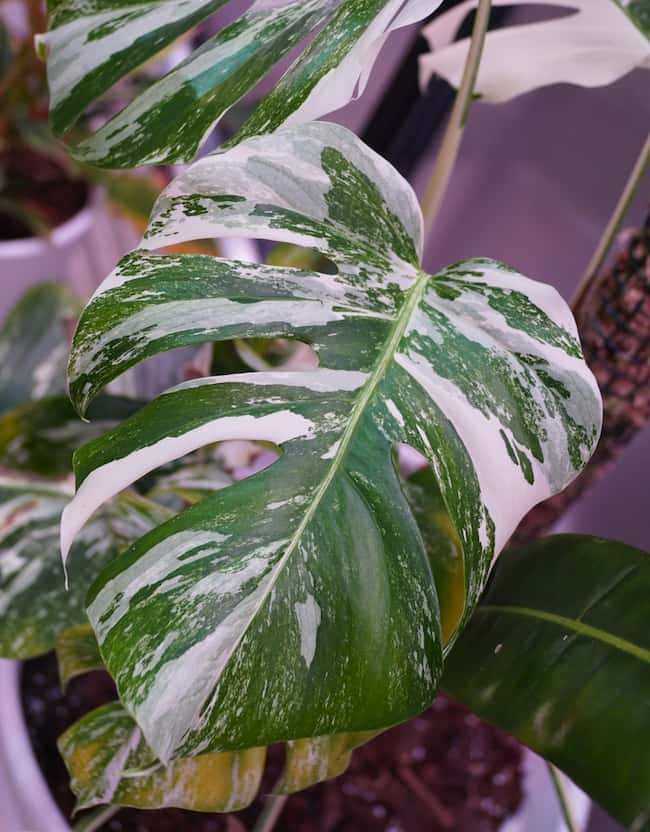
Monstera Borsigiana maintenance
Part of Monstera Borsigiana care is maintenance, which includes regular health inspections to make sure it isn’t suffering from an infestation or infection, as well as occasional pruning.
Any signs of yellowing, brown spots on your Monstera’s leaves, leaf drop, wilting, or drooping may be a sign that your Monstera is in ill health. Although hardy, the Borsigiana is vulnerable to root rot, so keep an eye out for overwatering.
Furthermore, try to prune your Monstera plant once or twice a year to preserve its energy and make room for new growth and development. Leaves do age as time passes, and removing them stops your plant from having to continuously feed them even though they’re past their sell-by date.
How much is a Monstera Borsigiana?
A Monstera Borsigiana for sale should only set you back around $35, but this depends on where you purchase it. Online, they may range in price from $20 to $100. Of course, their cost will also depend on how mature they are, how many leaves they have, and whether they are variegated or plain.
There is no precise art to pricing a Borsigiana, but a reasonable estimate is under $100. They are slightly pricier than Deliciosa, but again this depends on the size and condition of the specimen. For example, a cutting may be far cheaper to purchase than a mature plant.
Further confusing the issue is the fact that Borsigiana are often mismarked as Deliciosa, and vice versa. When buying these Monstera, there’s a great chance you won’t know what you’re getting until they mature.
As a side note, and if you’ve ever Googled “Monstera Borsigiana price,” you may come across some crazy figures. This is because listed pricing for these beauties often refers to their rare variegated form, which we will discuss in greater detail later in this article.
Does Monstera Borsigiana climb?
Monstera Borsigiana love to climb and will be well pleased with a totem or pole to attach to. Unlike the standard Deliciosa, the Borsigiana is inclined to grow upward rather than horizontally, attaching its aerial roots to its support as it grows.
Monstera Borsigiana are epiphytes, which means they have aerial roots as well as terrestrial roots. In their natural habitats, they grow in the shelter of large trees and use them to climb upwards towards the dappled sun above them. Monstera Borsigiana stems are specially adapted for this exact purpose.
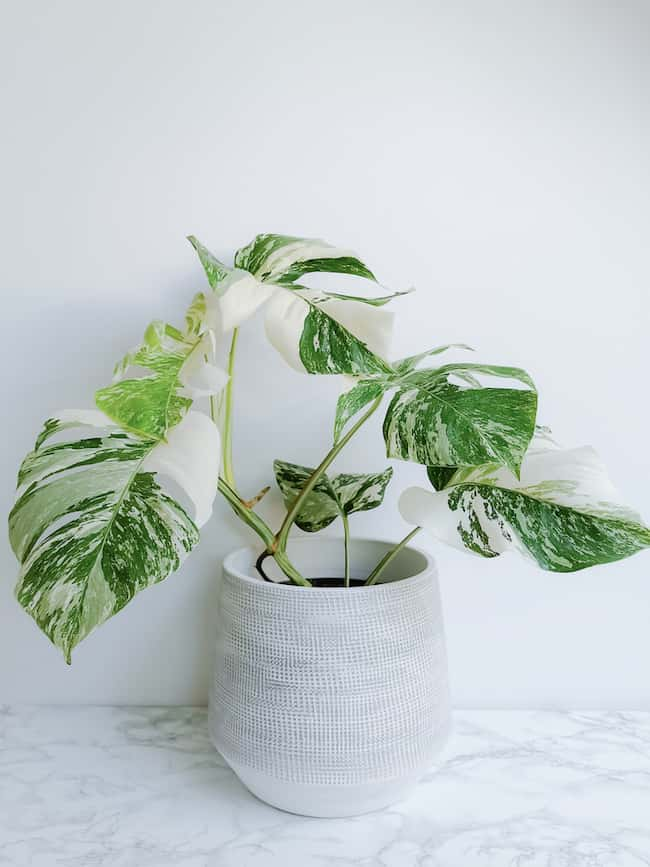
Given this, it makes sense that even in a home environment, they will thrive with a space to lay down their roots. Moss poles for a Monstera or even coco coir poles are my first choice because they have a texture similar to tree bark, making it easier for them to vine. Additionally, moss contains nutrients that they can absorb.
Of course, if you’re going for a specific aesthetic, you can also teach your Borsigiana to climb along specific structures like trellises. They may need your assistance at first, but once they start climbing, they should manage well on their own going forward.
To train a Monstera Borsigiana to climb, you may need to gently attach its aerial roots to your chosen structure with twine or florist’s tape. Do so gently, making sure not to obstruct its leaves or nodes, and remove your adhesives as soon as the roots have taken.
Is there a Monstera Borsigiana?
Yes, there is such a thing as a Monstera Borsigiana. It is a taxonomically distinct subspecies of Monstera Deliciosa. While they share many traits, it is commonly accepted that they do indeed possess structural and behavioral differences and can therefore be considered different plants.
The Monstera Borsigiana vs Deliciosa has sparked robust debate in the plant world, which is why most collectors choose to leave it up to the experts to classify. Historically, botanists have argued whether the Borsigiana is a plant in its own right, but of late, it is accepted that this variety of Monstera does indeed exist.
Where the confusion comes in is in the differences between these two plants. Usually, one of the most telling characteristics of a Monstera is its apertures, but Monstera Borsigiana fenestrations are identical to those of the Deliciosa and are no help in identifying it.
Then, there is also the question of growing conditions. Another argument around this topic is that indoor growing conditions determine a plant’s size, making the Borsigiana’s more diminutive stature a null point. However, it has been proven that even when these Monstera are in the wild, the Borsigiana remains smaller, so I feel it’s fair to say that fight can be laid to rest.
How do you pronounce Borsigiana?
Are you looking to impress your fellow Monstera collectors? The word “Borsigiana” is pronounced boar-see-ji-aana. Even better, technically, Monstera Borsigiana’s scientific name is “Monstera Deliciosa variety Borsigiana”.
And if you learn better from hearing rather than reading, take a look at the first 10 seconds of this video where the presenter pronounces it for you.
Is there a variegated Monstera Borsigiana?
Variegated Monstera Borsigiana do exist. In fact, the Monstera Borsigiana is one of the few plants in the Monstera family that can genetically develop white or cream-colored variegation. This phenomenon is incredibly rare and beautiful, and consequently, these specimens are highly sought-after and exceedingly expensive.
The variegated version of the Borsigiana is the unicorn of the plant world. These beauties follow no rules, popping up when and if they feel like it, and very seldom at that. In appearance, a variegated Monstera has cream or white patches or splatters on its leaves, which result from a genetic mutation. Somewhere in their make-up, cells misfire, and the result is entire parts of leaves are left with no chlorophyll and henceforth no color.
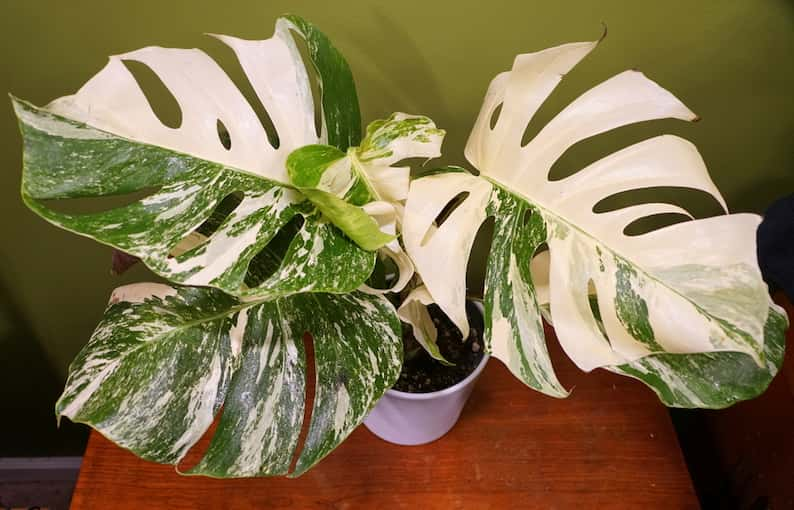
If it sounds like I’m waxing lyrical, it’s because these plants are just that breathtaking. They are also challenging to reproduce. In some parts of the world, Monstera producers will plant thousands of Monstera Borsigiana seeds in the hope that one will crop up with variegation. Still, ultimately there’s a better chance of reproduction via propagation.
But even then, there is no guarantee that Monstera Borsigiana babies will carry over the distinct white patterning of their parents. It’s a little bit luck of the draw. Currently, we rely on nature to take her course if we hope to get our hands on one of these, but ideally, one day, they’ll become more freely available.
If you do a lot of research on Monstera, you’ll know that these specimens rarely come up for sale, and when they do, they’re snapped up quickly by the highest bidder. To date, variegated Monstera plant prices are some of the highest ever recorded for plants at auction and show no sign of letting up anytime soon.
Monstera Borsigiana vs Thai Constellation
The main difference between a Monstera Borsigiana variegata and a Thai Constellation is that one is results from a genetic mutation and the other from tissue cultures developed in a lab. The Borsigiana is therefore much more uncommon and also more expensive.
At the moment, there is only one type of variegated Monstera that can be reproduced scientifically, and that is the Thai Constellation. Developed in a lab in Thailand, this beauty was born from tissue culture that covered the Monstera Deliciosa’s usually dark green leaves with distinct, cream-colored speckles. For serious collectors, this variety is an absolute must-have.
While still difficult to come by due to its slow growth and tricky maintenance, the Monstera Thai Constellation doesn’t have a penny on the Borsigiana variegata in terms of scarcity. The critical difference between the two is that the latter cannot be reproduced at will but instead needs to occur naturally, which it hardly ever does. And even when it chooses to grace us with its presence, it’s challenging to propagate successfully.
All that aside, there are also aesthetic differences between the two. The Borsigiana is smaller and more delicate, and its discolored pattering is more solid and less splattered. The Borsigiana likes to climb, where the Constellation grows more horizontally.
In pricing terms, the Thai Constellation is also somewhat cheaper.
